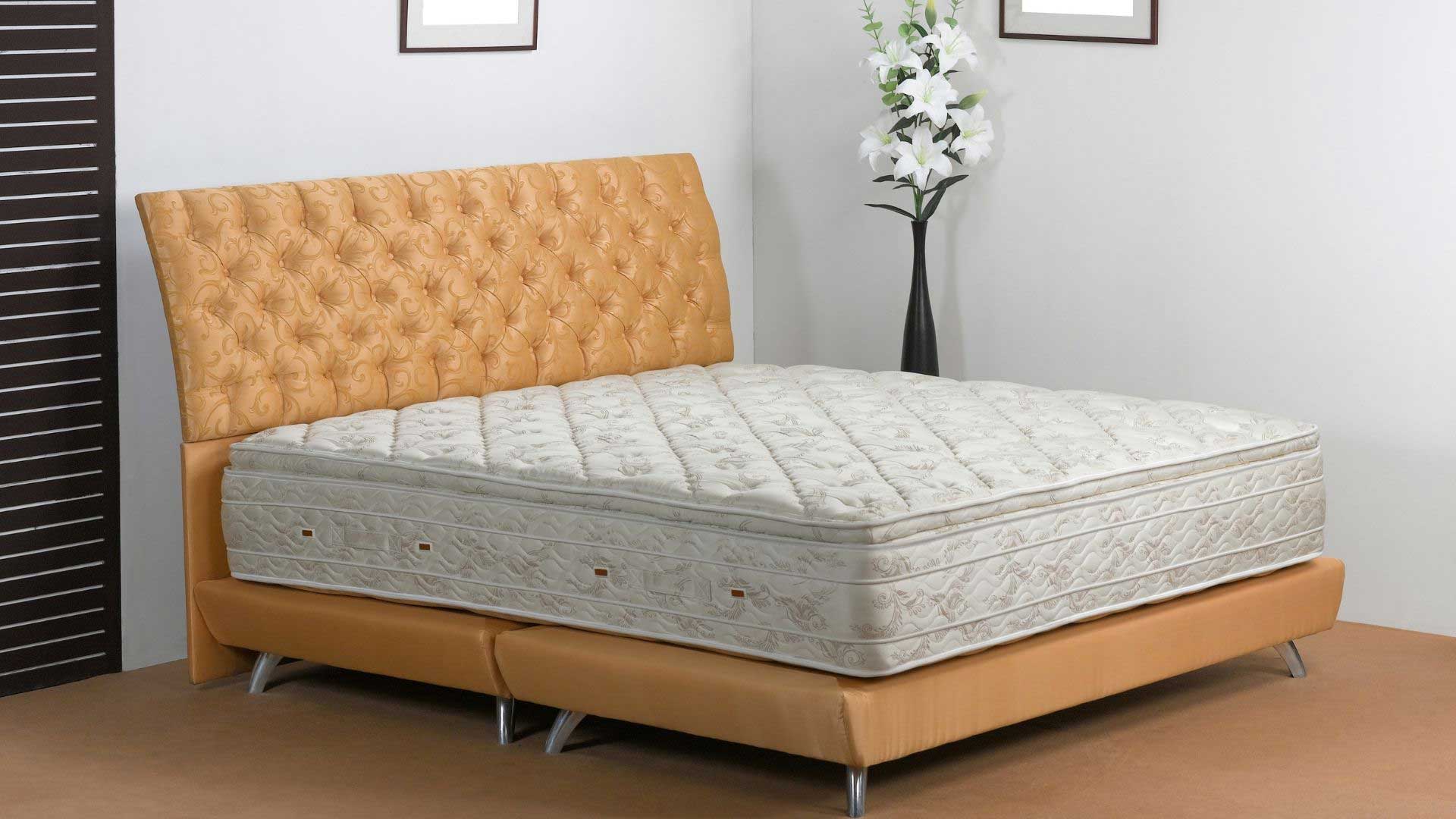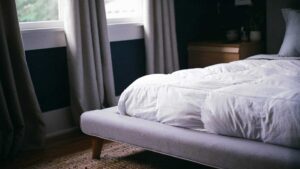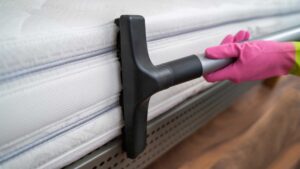Many people enjoy sleeping on mattresses. But who invented the mattress?
The history of the mattress shows that it wasn’t created by a single person. It was a lengthy process that started with a pile leaves and grew with time. Its primary function is to support your body and make it feel comfortable while you sleep.
Check out our Puffy mattress review.
Why Did Heinrich Westphal Invent the Bed?
The first innerspring mattress was likely invented in the 1870s by a Berliner named Heinrich Westphal. Westphal reused coils of steel that were used to support the seats of carriages to create a comfortable sleeping surface that did not compress under the weight of human beings. These mattresses were extremely popular by the 1930s and remain in use to this day. The innerspring mattress has seen many modifications and improvements.
People made piles of grasses, leaves, straw, and animal skins in the Stone Age to create insulation between their backs, the earth, and their bodies. Later, they would use feathers and animal skins in cloth sacks. Modern mattresses are made of innersprings, and are generally regarded as the work of Heinrich Westphal. The history of the mattress can be traced back to many other inventions of the same person.
Early mattresses used straw and grass as well as horsehair as fillers. Heinrich Westphal invented the first innerspring mattress in the 1870s. The mattress’s innerspring was not widely popular until the 20th Century. John Boyd Dunlop invented latex foam in 1921. The process of making latex foam was refined by E.A. Murphy in 1931. The first latex mattress was created in 1931.
William Lawrence Murphy
William Lawrence Murphy, an inventor of the foldaway bed made his life simpler in the early 1900s. Living in a single room, Murphy wanted to have more space to entertain his friends. The bed he was using took up the majority of the floor and he wanted to be able to have guests stay over without disturbing his neighbors. Murphy developed a mechanism that could fold the bed against the wall when it was not in use. He patented the system in 1911. The Murphy bed was a hit as more people moved into cities and made their homes more practical.
Murphy experimented with wall bed designs after the wedding. Due to social norms at the time, women could not be allowed in the bedrooms of males. However, Murphy wanted to give women the right to access his bedroom. He later patented the Murphy bed and the invention was promoted in newspapers in San Francisco and Sacramento. It is now an undisputed image in American history. If you are interested in Murphy’s life and his inventions the story is fascinating.
Though the bed was invented in 1849, it was not popular until the 1930s. The Great Depression closed down factories and steel rationing cut off production during World War II. After the war, more people were building their own homes and relocating from apartment buildings. A court decision in 1989 allowed the use of the “Murphy bed”, in advertising and in naming. The bed has since evolved into a popular alternative to traditional beds.
Harrods Mattresses
The history of the Harrods mattress dates back to 1861. The famous department store was initially known as Kendals. The name was changed to Harrods in the 1920s following Sir Richard Burbidge 1st Bt. who was born in Wiltshire. Before Harrods hired him to manage the newly-opened store, he had previously worked in three London department stores. Harrods is renowned for its mattresses of high quality that have been in use for more than a century.
Harrods opened its first store in 1849 where customers could purchase fruit and vegetables. The store was later expanded to include a food hall with oysters and caviar as well as champagne. A person who reviewed the food hall at Harrods observed that the conveyor belt was “delightfully moving” and was the perfect way to move around the store. Harrods has a huge shoe section and boutiques from designer brands.
A waterbed was first offered by Harrod’s in 1895. The shape of the waterbed was an enormous hot-water bottle, but was later discarded due to a lack of suitable materials. The mattress did not sell well and was not even sold in its own stores. However, it did become a classic over the following century. It was popularized in the United States in 1915. It is still one the most expensive mattresses available, and the price tag is staggering.

Dunlop Latex Mattresses
Dunlop, an entrepreneur from the 1930s, found that natural latex used to create mattresses could be reused. This process is based upon a process called vulcanisation, which uses steam to trigger cross-linking reactions among the polymer chains. This results in a layer that is more dense at its bottom than at its highest. Dunlop’s product is different from Talalay is organic.
While Talalay and Dunlop utilize different processes to make their foams they have the same advantages. Both contain latex however their manufacturing processes are different. The Dunlop method results in a more firm mattress, and it uses only one pouring and baking process to create it. Talalay produces a softer, uniform foam that is less dense than Dunlop. While the Talalay process is more expensive but the difference between the two processes is nearly invisible.
The latex used in Dunlop mattresses has a springy feel and is more pliable. The material is responsive to movement and can re-form to the user’s shape. This kind of latex is most effective when used as the top layer of a mattress. its firmness is ideal for supporting the base layer. While Talalay latex is a more affordable alternative, Dunlop is better for the environment and is more robust. In addition to the firmness it provides, Dunlop latex mattresses can be made using up to 100% natural ingredients.
Kiln-dried latex
The process for making a mattress made of latex is straightforward however the method used to make it is anything but straightforward. The natural material is poured into a giant waffle iron, which is then ‘vulcanized’. The liquid rubber transforms into a solid during this process. The product that is created is extremely buoyant and flexible. The blocks of latex are then cut into American-sized blocks , and then covered with an external mattress in a encasement. In some instances, a deluxe latex mattress could also come with an additional coil system to provide comfort.
A mattress that is made of 100 percent natural latex is a much better choice for the environment. It helps to promote the growth and development of rubber trees, which remove carbon dioxide from the atmosphere and create jobs for tappers. It is also better for your health as it biodegrades over the years. Latex mattresses are also a good choice if you like to sleep hot. The natural, breathable material helps disperse heat, and memory foams tend to store heat.
The Dunlop method, a more traditional method for making latex mattresses is still being used. It was first employed in 1931, and is now the most sought-after kind of latex. It’s difficult to create a softened version of latex using the Dunlop method due to the fact that it takes a long time to form into the mold. This is why it’s typically used in the support layer or the core layer of the mattress. A Dunlop mattress is also a firmer choice.
Who Invented the First Mattress?
The first mattress known to be used was probably developed by Homo erectus which was a species that lived about 1.89 million years ago. The early hominids might have been able to use a mattress that was ground due to the use of fire. Richard Wrangham, a Harvard biological anthropologist, suggests that the ability to cook and process food made the use of fire less crucial than sleeping in the trees.
H. erectus, the first human to venture out of Africa was more terrestrial than its relatives. Its long legs and Achilles tendons that were long as well as its the ability to travel over long distances enabled it to achieve this feat. Although the species was believed to have died about 100 million years ago, the latest fossil-bed redating suggests that hominins are around 117,000 to 108,000 years old. This shows that they could live in a variety of regions of the world.
The fossils found in Indonesia are the first evidence that Homo erectus is alive outside of Africa. These skeletons were found in Indonesia around three million years ago. They are as old as the great apes. The hominins migrated to Africa three million years ago and likely interacted with their Denisovan ancestors. They are the oldest and most mysterious of the ancient human beings. The Homo species erectus population spread across Africa and into western Asia’s Caucasus Mountains. The elderly male in the group would have died from age-related illnesses, and his teeth and jaw would have been lost towards the end of his life. This means that the elderly male would be taken care of by his family members and possibly by members of his social group
The diet of early Homo erectus was extremely diverse. Apart from animals and meat the apes ate fish, insects and even reptiles. It also ate various fruits, vegetables, and roots. It is unlikely that this species created the mattress, though there are some evidences that suggest it had a varied diet. Homo erectus was a multi-ethnic genus that ate a variety of plants and animals, including scorpions birds, scorpions, birds, and centipedes.
When Were Spring Mattresses Invented?
In the Stone Age, humans would gather to share warmth. They would sleep on the ground and it was the Neolithic humans who first invented mattresses. The first mattresses they built were likely made of grass or animal skins, covered with grass and leaves. Later, Persians and Egyptians would fill goat skins with water and use them as mattresses. Numerous improvements were made to spring mattresses during the Dark Ages.
The beds were made more basic as the 19th century progressed. Four-poster beds ceased to be in fashion and spring mattresses became popular. Harrods sold the first spring mattresses made of coil in the 1870s. Later artificial fillers were popularized and spring mattresses were introduced to replace box springs. Foam mattresses became popular in the 1960s and the Tempur-Pedic company began making mattresses made of NASA memory foam. In the 21st century, we have infinite options for comfort and design.
The coil spring was first invented in 1857 and was first patented in 1865. It was first used in mattress and chair seats. Heinrich Westphal invented the mattress with an innerspring in 1871. He died in 1891 from Famine. The innerspring mattress was a hit, but the waterbed was not. In the 1880s, the boxspring was invented, and today, many mattresses are made of steel or iron.
What Were Mattresses Made of In The 1600s?
What was the substance used to make mattresses in the 1600s? How did they get made? You may be surprised by the answer! The materials used in mattresses were not much different from what we know today. The stuffing was made mostly of linen or cotton. The counterpane followed. The covers were often made of intricately woven or embossed cloth. New Englanders also utilized “bed rugg” to cover their beds. This is a thick, wool-like spread made from looped wool. This kind of mattress is perfectly illustrated in George Washington’s camp bed from 1783. It is displayed at the Henry Ford Museum in Dearborn, Michigan.
Beds were typically made of elaborate wood and other materials. Many of them featured elaborate carvings and inlaid artworks. Some of these beds were raised over the floor, covered with heavy velvet drapes or canopy. Four-poster beds were popularized in the Victorian time. These beds were often adorned with fanciful flowers or fruit and were topped with heavy fabric curtains.
The Middle Ages of England were the first time “mattress” was used. It is believed that the term “mattress” was first used during the Crusades when English-speaking travelers travelled to the Arabic-speaking regions of. The world’s oldest mattress is 77,000 years old it was discovered in KwaZulu-Natal in South Africa. This mattress was made of layers of plant material, which were burned to repel insects. The mats were about twelve inches thick and covered an area of 22 square feet.
History of Mattresses
Mattresses were not used in the past to sleep, despite their modern amenities. The oldest mattress recorded was found in South Africa, at the border cave archeological site. It was constructed from grass and ashes and was used by humans approximately 200,000 years ago. According to research that this material was used to repel insects and would have been extremely beneficial to keep mosquitoes away while they slept. As the human evolution continues, the evolution of mattresses has continued.
Persia was the home of the first waterbeds, which were discovered around 3600 BC. Persia developed these water beds by filling goat skins with water. The water mattress was a luxury item for the wealthy, but it was mostly unsuccessful and didn’t last. Instead, people made use of animal skins and stuffing. Mattresses made of water required constant maintenance and transfer motion. The market was dominated by innerspring and box spring mattresses in the 1950s.
Prior to the common era the first mattresses were made from goatskin, reeds, and straw. The Romans used cloth bags for mattresses and the Ancient Egyptians utilized palm boughs for their sleep. In both countries, common people utilized reeds, wool, and hay for mattresses, while rich people filled with fur and feathers. However the Romans were not the only ones to use the waterbed.
In the 1920s, latex foam was developed in the 1920s. The synthetic material has since been used in countless products. They are still readily available even today. In 1931, the first ever latex mattress was created. There have been many breakthroughs in mattress history however, the most important is the invention memory foam. It was used by NASA scientists to make mattresses in early 20th-century. Later they were utilized to treat medical conditions. It’s also worth noting that there are many historical examples of waterbeds.
FAQ
What did humans sleep on before beds?
Humans used to sleep on homemade sleeping surfaces like straw mounds before the days of Tempur-Pedic and Casper. Primitive mattresses were made out of stuffed materials as society progressed, and down was introduced. Bedframes were invented considerably later, yet they have been around since the time of the ancient Egyptians.
Where did the mattress originate from?
Piles of leaves and grass were utilized as mattresses, which were then covered in animal skins. Around 3100 to 1200 BC, Egyptians began using elevated beds made of palm leaves. The first luxury beds were created by the Roman Empire. Raised platforms with gold, silver, and bronze decorations.
Who invented mattress in a box?
While Casper gets a lot of the credit, the mattress-in-a-box was designed by a machinist in Johnson City, Tennessee, seven years before Casper started.
What were mattresses made of in the 1950s?
Mattresses were still packed with cotton instead of springs as late as the 1950s. Cotton tended to clump and harden over time, whereas springs tended to soften.
What was the first foam mattress?
Firestone’s polyurethane foam mattress was the first to be released in the 1950s, followed by foam rubber (today known as “latex foam”) mattresses. They only had a minor impact on innerspring mattress sales. The origins of memory foam can be traced back to the US space program.



